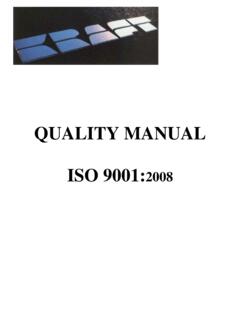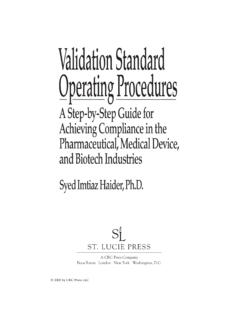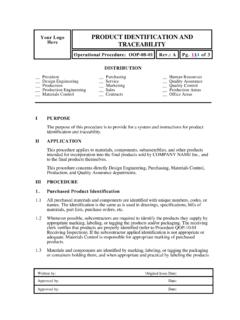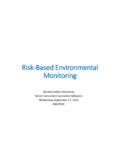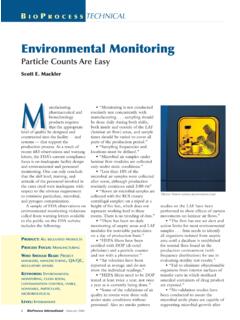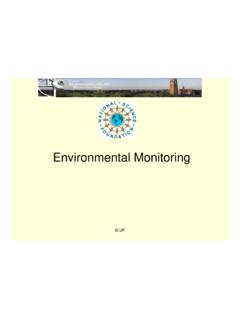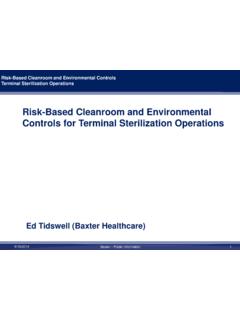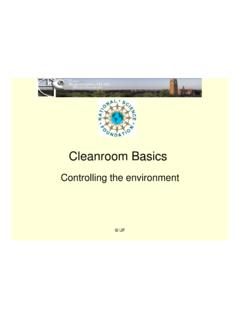Transcription of GUIDELINES ON TEST METHODS FOR …
1 GUIDELINES ON TEST METHODS FOR environmental monitoring FOR aseptic dispensing FACILITIESPRODUCED BYA WORKING GROUP OF THE SCOTTISH QUALITY ASSURANCE SPECIALIST INTEREST GROUP SECOND EDITION FEBRUARY 2004 1 ContentsPage NumberGeneral Introduction2 Test Methodologies3 Section 1- Physical Tests4 Introduction41. Non-viable particle counts52. Pressure differentials93. Airflow velocity114. Air change rate135. Operator protection factor156. Filter Integrity Testing16 Section 2 - Microbiological Tests17 Introduction17 General Information- Sample equipment 17- Sampling conditions17- Sample locations18- Incubation conditions18- Results and reading of samples18- Action levels19- Action to be taken in the event of a result being on or over the action level197.
2 Use of settle plates208. Determination of airborne microbiological contamination by active air sampling239. Use of finger dab plates2510. Use of contact of swabs29 Definitions32 References33 Appendix I Example of a Certificate of Analysis/FertilityAppendix II - Abnormal Event Log2 General Introduction [1], [2], [3]This document was originally compiled in response to a need from the Scottish aseptic Services Specialist Interest Group (ASSIG) and Quality Assurance Specialist Interest Group (QASIG) membership for more specific guidance on the various environmental monitoring techniques used to demonstrate conformance to accepted clean room standards and the requirements of current Good Manufacturing Practice (cGMP).
3 This revised version takes into account the many changes that have occurred to standards since the original was produced. Since publication of the first edition parts of BS EN ISO 14644 Cleanrooms and associated controlled environments have come into existence and those parts that have been issued for use have been considered in the preparation of this guidance document. It should be reiterated that this document is intended as an interpretation of relevant standards. If there is any doubt over a specific area then reference should always be made to the original standard. monitoring of both physical and microbiological contamination remains essential in aseptic operations to provide ongoing information on the maintenance of a stable and suitable environment for the aseptic preparation of products for administration to patients.
4 This guidance document contains general information on physical and microbiological test METHODS and should be used in conjunction with the original source documents where more detailed information may be obtained. Sample monographs are provided here containing guidance on all aspects of the specific test METHODS . The layout of this document is in accordance with the GUIDELINES on environmental monitoring for aseptic dispensing facilities [1] with section 1 covering physical test METHODS and section 2 covering microbiological test METHODS . It is recommended that monitoring performed should be at least at the minimum specified frequencies in order to provide the necessary personnel within the aseptic preparation department must have an understanding of clean room and clean air device technology together with a thorough knowledge of all the features in their department, ventilation systems, position and grade of HEPA filters, types of clean air devices etc.
5 It is preferable for certain tests, airborne particle counting, active air sampling or settle plates, that sampling is performed in the operational condition rather than the at rest state. It should be stressed that such sampling should not interfere with critical work zone protection. Results from monitoring should be considered (even in retrospect) when reviewing documentation for finished product release. It is recommended when monitoring in the operational state, where an active sampling method is used particle counting or active air sampling, that the testing is performed during routine operator or process simulation tests, in order not to compromise the quality of any products prepared that may be administered to patients.
6 Testing in the at rest state can be carried out to monitor baseline contamination levels. Surfaces and personnel should also be monitored at the frequencies stated. A report of the test data indicating the significance of the results and any corrective action must be brought to the attention of all relevant staff (at team meetings) and full records kept on file for future reference. Particular importance should be placed on obtaining meaningful results, monitoring trends, setting in-house standards, where appropriate, and action obtained from all monitoring , by in-house or external contractors, should be actively and knowledgeably assessed by either the Responsible Pharmacist or the Quality Assurance/Control Pharmacist, and any necessary action taken and not merely filed for record methodologies[4]Testing physical parameters as a means of measuring the performance of equipment/ facilities is accepted practice.
7 The physical tests performed are reproducible and accurate and can be used to validate the facilities /equipment's performance against accepted criteria airborne particulate contamination, pressure differentials, clean room air change rates. Testing microbiological parameters as a means of evaluating equipment/ facilities performance is less accurate as the means of determination are highly variable. Microbiological levels in the environment are not uniformly distributed in a given area and fluctuate with time. It is therefore vital that test methodologies exist as part of the environmental monitoring programme. Each test method selected for routine monitoring should be validated.
8 If changes are made to test METHODS , variations may introduce unknown variability and comparisons between data are spurious. It is essential that test methodologies are defined and complied with so that trends in contamination levels may be compared. It is important to emphasise that failure to comply with the methodologies may render the samples collected invalid. Each test result should be reviewed in the context of previous and subsequent samplings with the major emphasis on detecting patterns within the data 1:PHYSICAL TESTSI ntroductionTesting may be carried out by internal staff ( aseptic /QA/QC) or by external contractors. If external contractors carry out testing then they should be registered or accredited to a recognised qualification Cleanroom Testing and Certification Board (CTCB) of the Scottish Society for Contamination Control.
9 In either case it is essential that testing is carried out using recognised test METHODS , by trained staff and is in accordance with an agreed test specification, which outlines which tests are to be carried out. Test sites have the responsibility for ensuring that clean air devices are in a clean and safe condition, free from cytotoxic contamination, before internal staff or external contractors test tests outlined in section 1 are physical tests that may be carried out for monitoring conventionally ventilated rooms housing one or more clean air devices. The clean air supply to these rooms is generally through one or more grilles in the ceiling (often with HEPA filters in place) and air is extracted by loss to adjacent rooms or through extract grilles (usually at low level).
10 The clean room operates on the principle that the air supplied is of sufficient quantity to dilute or remove the contamination generated in the used for any tests should be calibrated and traceable to national standards. Where the test is performed by an external service contractor a valid certificate of calibration for the test equipment used should be supplied with the test report. Steps should be taken to ensure that equipment used by in-house staff or external contractors for performing monitoring tests has been suitably cleaned and maintained prior to any testing being carried and exit of all personnel and equipment to the clean room (s) or device(s) under test must be in accordance with the site standard operating procedure(s).


